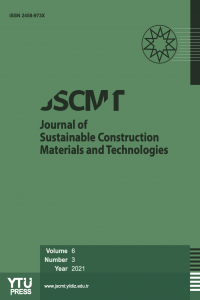An Investigation of High Speed Transport Systems: Design and Geodynamics
An Investigation of High Speed Transport Systems: Design and Geodynamics
Ballast, Critical Speed, Rail Systems, Rail Systems, Vibration Train, Ground,
___
- 1. Kouroussis G., Connolly D.P., Olivier B., Lagh- rouche O., Costa P.A., (2016), Railway Cuttings and Embankments: Experimental And Numerical Stud- ies of Ground Vibration, Elsevier Science of the To- tal Environment, 557-558 (2016) 110-122.
- 2. Sheng X., Jones C.J.C., Thompson D.J., (2004), A Theoretical Study on The Influence of The Track on Train-Induced Ground Vibration, Elsevier Journal of Sound and Vibration 272 (2004) 909-936.
- 3. Costa P.A., Calçada R., Cardoso A.S., (2012), Track– Ground Vibrations Induced by Railway Traffic: In-Situ Measurements and Validation of A 2.5D FEM-BEM Model, Elsevier Soil Dynamics and Earthquake Engineering, 32 (2012) 111-128.
- 4. Costa P.A., Calcada R., Cardoso A.S., Bodare A., (2010), Influence Of Soil Non-Linearity on the Dy- namic Response of High-Speed Railway Tracks, El- sevier Soil Dynamics and Earthquake Engineering, 30 (2010) 221-235.
- 5. Madshus, C., Lacasse, S., Kaynia, A., Harvik L., Geo- dynamic Challenges in High Speed Railway Projects, ASCE Geotechnical Engineering for Transportation Projects, 192-215.
- 6. Connolly D., Giannopoulos A., Fan W., Woodward P.K., Forde M.C., (2013), Optimising Low Acoustic Impedance Back-Fill Material Wave Barrier Dimen- sions to Shield Structures from Ground Borne High Speed Rail Vibrations, Elsevier Construction and Building Materials, 44 (2013) 557-564.
- 7. Hall L., Simulations and Analyses of Train-Induced Ground Vibrations in Finite Element Models, (2003), Elsevier Soil Dynamics and Earthquake En- gineering, 23 (2003) 403-412.
- 8. Thompson D.J., Jiang J., Toward M.G.R., Hussein M.F.M., Dijckmans A., Coulier P., Degrande G., Lombaert G., (2015), Mitigation of Railway-In- duced Vibration by Using Subgrade Stiffening, Else- vier Soil Dynamics and Earthquake Engineering, 79 (2015) 89-103.
- 9. Bian X., Li W., Hu J., Liu H., Duan X., Chen Y., (2018), Geodynamics of High-Speed Railway, Else- vier Transportation Geotechnics 17 (2018) 69–76.
- 10. Nelson J.T., Saurenman H.J., (1987) A Prediction Procedure for Rail Transportation Groundborne Noise and Vibration. Transportation Research Re-cord, 26-35.
- 11. Krylov V.V., (1994), Generation of Ground Vibra- tions by Superfast Trains, Elsevier, 44 (1995) 149- 164.
- 12. Galvin P., Dominguez J., (2009), Experimental and Numerical Analyses of Vibrations Induced by High- Speed Trains on the Cordoba-Malaga Line, Elsevi- er Soil Dynamics and Earthquake Engineering 29 (2009) 641-657.
- 13. Sheng X., Jones C.J.C., Thompson D.J., (2004), A Theoretical Model for Ground Vibration From Trains Generated by Vertical Track Irregularities, Elsevier Journal of Sound and Vibration, 272 (2004) 937-965.
- 14. Galvin P., Romero A., Dominguez J., (2010), Vi- brations Induced By HST Passage On Ballast And Non-Ballast Tracks, Elsevier Soil Dynamics and Earthquake Engineering, 30 (2010) 862-873.
- 15. Esen I., Eroglu M.., (2016), Balast Sertliğinin Raylı Sistem Dinamiğine Etkisinin İncelenmesi, 3. Uluslararası Raylı Sistemler Mühendisliği Sem- pozyumu (ISERSE’16), 13-15 Ekim 2016, 513-519.
- 16. Ozturk Z., Uluc M., (2013), Balastsız Üstyapılarda Aralıklı Desteklenmiş Raylı Sistemlerin İncelenme- si, 2. Uluslararası Raylı Sistemler Mühendisliği Sem- pozyumu (ISERSE’13), 9-11 Ekim 2013.
- 17. Nsabimana E., Jung Y-H., (2015), Dynamic Subsoil Responses of a Stiff Concrete Slab Track Subjected To Various Train Speeds: A Critical Velocity Per- spective, Elsevier Computers and Geotechnics, 69 (2015) 7-21.
- 18. Bian X., Jiang H., Cheng C., Chen, Y. Chen, R. Jiang J., (2014), Full-Scale Model Testing on a Ballastless High-Speed Railway Under Simulated Train Moving Loads, Elsevier Soil Dynamics and Earthquake En- gineering, 66 (2014) 368–384.
- 19. Galvin P., Romero A., Domínguez J., (2010), Fully Three-Dimensional Analysis Of High-Speed Train– Track–Soil-Structure Dynamic Interaction, Elsevier Journal of Sound and Vibration, 329 (2010) 5147- 5163.
- 20. Dong K., Connolly D.P., Laghrouche O., Woodward P.K., Costa P.A., (2019), Non-Linear Soil Behaviour on High Speed Rail Lines. Elsevier Computers and Geotechnics, 112 (2019) 302-318.
- 21. Yu Z., Woodward P.K., Laghrouche O., Connolly D.P., (2019), True Triaxial Testing of Geogrid For High Speed Railways, Elsevier Transportation Geo- technics, 20 (2019) 100247.
- 22. Mezher S.B., Connolly D.P., Woodward P.K., Lagh- rouche O., Pombo J., Costa P.A., (2016), Rail- way Critical Velocity - Analytical Prediction and Analysis, Elsevier Transportation Geotechnics, 6 (2016)84-96.
- Başlangıç: 2016
- Yayıncı: Yıldız Teknik Üniversitesi
Characterization of crack healing of asphalt mixtures treated with healing agents
Unprocessed calcareous fly ash as a partial cement replacement in self-compacting concrete
Adnan MUJKANOVIĆ, Dženana BEČIRHODŽIĆ, Ilhan BUŠATLIĆ, Marina JOVANOVIĆ
An Investigation of High Speed Transport Systems: Design and Geodynamics
Setenay AKÇA, Mehmet Fatih ALTAN
Effect of opening layout and sheathing on lateral load bearing capacity in wooden shear walls
